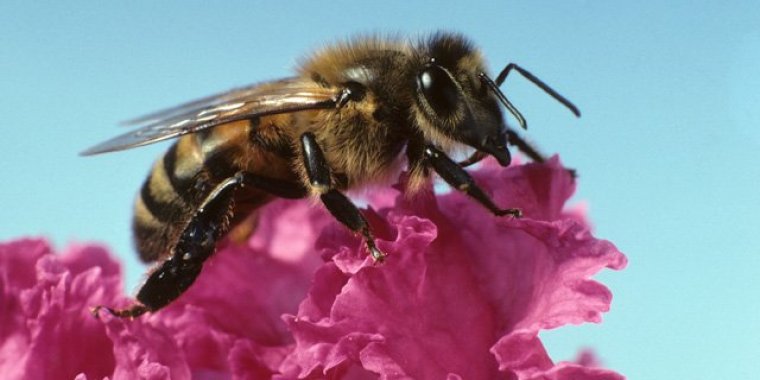| News / Science News |
Species Shifts in the Honey Bee Microbiome Differ with Age and Hive Role
The makeup of microbial species—the microbiome—in a honey bee queen’s gut changes slowly as she ages, while a worker bee’s microbiome changes much more rapidly, according to a new study published by Agricultural Research Service (ARS) scientists.

Species Shifts in the Honey Bee Microbiome Differ with Age and Hive Role. Photo courtesy of USDA ARS/Rob Flynn
Honey bee queens, which lay all of the eggs in a hive, commonly last about three years in managed colonies before beekeepers replace them as reproduction slows. But in recent years, queens have been failing more quickly. This is a factor in higher colony losses reported during the past 12 years and has increased beekeepers’ costs and labor.
The honey bee gut microbiome plays a significant role in metabolism, development and growth, and immune system function and protection against pathogens.
Five to seven bacterial species groups usually make up the vast majority of a honey bee’s core microbiome from among a common list of 10-12 species groups. The exact mix depends on a honey bee’s age and function in the hive.
Scientists found that as a queen ages, in her gut microbiome, the levels of two bacterial species groups slowly increase: Lactobacillus and Bifidobacterium, both known for providing probiotic benefits in mammals including humans.
At the same time, her microbiome has decreased levels of Proteobacteria species, which are often associated with unhealthy microbial imbalances.
The rate of this shift is associated more with a queen’s biological age than her chronological age. Queens age biologically at different rates depending on their colony’s exposure to a variety of environmental stresses, which can include available nutrition and exposure to temperature extremes.
Interestingly, during this study, the researchers discovered a new potentially queen-specific pathogen not detected in any adult worker bees—Delftia bacteria (in the order Burkholderiales).
The occurrence of Delftia in the queen’s mouth and gut rose or fell opposite to the levels of bacteria considered beneficial. This suggests Delftia may play a part in early queen mortality.
In comparison, Lactobacillus and Bifidobacterium levels dropped, and the number of Proteobacteria went up as worker bees aged. Workers’ microbiomes appear to change in a highly predictable fashion, especially with age. This may mean early shifts in worker microbiota could be used as a warning indicator for colony dwindling and/or failure.
Applying this new information to enhancing honey bees’ microbiome may represent a new strategy to slow their aging or to combat physiological stress.
In addition, as understanding of the honey bee’s relatively straightforward microbiome increases, the ARS researchers are hopeful that bees may offer an excellent model in which to study the much more complex microbiome of other species including humans. (U.S. Department of Agriculture)
YOU MAY ALSO LIKE



